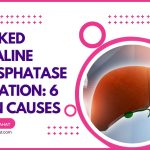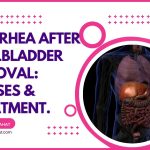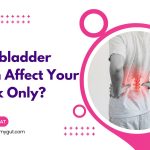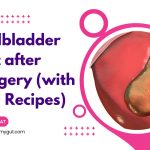Back Pain After Gallbladder Surgery: Causes & Incidence.
Our content is not intended nor recommended as a substitute for medical advice by your doctor. Use for informational purposes only.
- Back pain after gallbladder surgery is one of the most common complaints.
- The pain is more common in patients undergoing open cholecystectomy compared to the laparoscopic technique.
- In most cases, back pain will resolve within a few days.
- However, Some patients may continue to have back and abdominal pain for months or years after gallbladder removal.
How common is back pain after gallbladder removal?
A. Long-term pain (for months or years):
Gallbladder removal surgery (cholecystectomy) remains the gold standard for treating gallstones. However, gallbladder surgery doesn’t result in 100% symptom resolution.
The typical gallbladder pain (upper right or central abdominal pain radiation to the back and right shoulder) may continue after gallbladder surgery.
The mechanisms of continued back and abdominal pain is not fully understood (read the suggested causes or mechanism below in the third section).
One study found that 30% of patients may continue to experience different types of pain after undergoing cholecystectomy.
10 out of the 92 patients included in the study experienced typical biliary colics (including back pain) after an average follow-up of one year.
The table below illustrates different types of pain after gallbladder surgery and their frequency (reference).
| Pain Type | Frequency (%) |
| 1. Biliary colic (right upper abdominal and back pain). | 11% |
| 2. Indigestion pain | 18.50% |
| 3. Isolated right upper abdominal pain. | 16.30% |
| 4. Heartburn. | 12% |
Another study found that 13% of patients may continue to have pain (including back pain) after gallbladder surgery (reference).
B. Short-term pain (hours or days).
The short term back and shoulder pain after gallbladder surgery is common.
One study found that up to 62% of patients undergoing laparoscopic gallbladder removal have shoulder-tip pain (shoulder-tip pain is often associated with back pain) 12 hours after the operation.
The same study found that shoulder tip and back pain may be related to the longer duration of the procedure.
Acute postoperative pain often resolves within a few days but may continue for weeks.
What are the typical locations of back pain after gallbladder removal?
The right shoulder blade (at the midback) is the typical location of back pain after gallbladder surgery is the right shoulder blade (at the midback). Also, pain commonly affects the tip and the back of the right shoulder.
Less commonly, The pain may extend to the loin or the lower back.
MORE: 9 Causes of Bigger Stomach after Gallbladder Surgery.
Causes of back pain after gallbladder removal?
A. Causes of short-term pain (lasting for hours or days).
Short-term back pain, shoulder-tip pain, and abdominal pain are widespread. For example, up to 60% of gallbladder surgery patients will have pain shortly after the operation (reference).
Causes include:
- Longer duration of the operation.
- Continued gallbladder bed inflammation leads to the continuation of the pain.
- The missed stone inside the bile ducts.
- Inflation of the peritoneum with gas (Co2) leads to phrenic nerve irritation.
- Postoperative wound infection.
- Injury or ligation of the bile ducts during the operation.
B- long term back pain after gallbladder surgery.
- Post-cholecystectomy syndrome.
- Missed or newly formed stones inside the biliary ducts.
- An alternative diagnosis such as the sphincter of Oddi dysfunction.
- Spine diseases.
- Back muscle strain.
- Pleurisy (inflammation of the tissue enveloping the lung).
- Irritable bowel syndrome.
The origin (source) of back pain after gallbladder removal.
Back pain after gallbladder removal is either of:
- Biliary origin.
- Non-biliary origin (muscles, spines, ribs, lung pleura, or other internal organs).
The hallmark of biliary-type pain after gallbladder removal is the presence of typical biliary colics. The typical biliary colic often is a combination of moderate or right upper abdominal pain (see the table below).
| Biliary colic | Description |
| 1. Site | Usually, The right upper quadrant of your abdomen. |
| 2. Spread | – The pain may spread to the back of the right shoulder. – Also, it spreads to the epigastric area. |
| 3. Character | Constant builds up then disappears gradually. |
| 4. Duration | At least 30 minutes. It may last up to 6 hours. |
| 5. Relation to food | – Triggered by foods (especially fatty food and large meals. – However, it can start spontaneously. |
| 6. NOT related to:Movement, bowel movements, or the passage of flatus. | |
| 7. Nausea | Often Present, severe. |
| 8- Commonly associated symptoms | Vomiting, sweating during the attack. |
| 9. Unusual symptoms. | – Heartburn and chest pain. – Bloating, fullness. – Early satiety. – Isolated epigastric pain. |
| 10. Symptoms NOT associated: | – Fever. – Jaundice. – Prolonged pain for more than 6 hours. – Extreme tenderness over the gallbladder (Murphy’s sign). – Vomiting of blood, blackish stool (PUD). |
Non-biliary back pain is often not associated with abdominal pain or meals. Instead, it may be related to movements (spine, muscle, or rib pain) or breathing (as with pleural pain).
Treatment and when to see a doctor?
The short-term back pain after gallbladder surgery often responds to analgesics such as nonsteroidal anti-inflammatory drugs (NSAIDs). Expect pain for a few days after the operation.
The treatment of long-term back pain after gallbladder surgery depends on its cause. You should consult your doctor if the pain affects your daily life or eating.
Postcholecystectomy syndrome is one of the most typical causes of abdominal and back pain after gallbladder removal. The treatment of postcholecystectomy syndrome depends on its cause (Learn More about this condition).
See a doctor for back pain after surgery if:
- Severe pain that is not going away for days after the operation.
- Associated fever.
- Associated with severe biliary-type pain (severe right upper abdominal pain with back pain).
- Nausea or vomiting.
- Associated with severe abdominal pain or tenderness.
- Jaundice (yellowish discoloration of the skin and eye whites).
- Pale stool or tea-colored urine.
- Prolonged back pain for weeks, months, or years with no apparent cause.
- Evidence-based
- Written by a doctor.

Related Posts:
- Can Gallbladder Pain Affect your Back Only?…
- Safest Gallbladder Diet after Surgery (with 60+ Recipes)
- 6 Causes of Bigger Stomach after Gallbladder Surgery…
- Liver Complications after Bariatric Surgery.
- 6 Problems After Gallbladder Removal, Years Later…
- Diarrhea After Gallbladder Removal: Causes, How Long…





